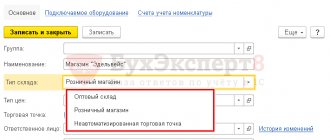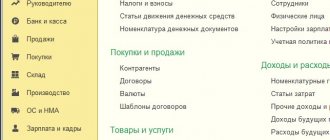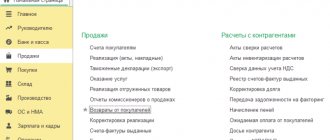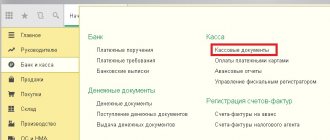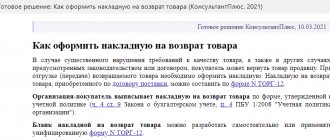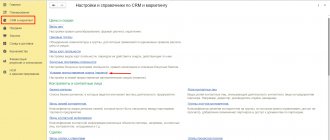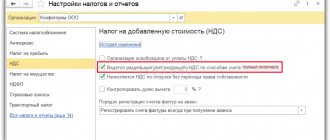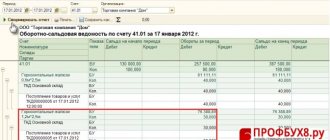If the goods do not comply with the terms of the contract or are of poor quality, the buyer has the right to return it to the supplier. Processing a return from a buyer in 1C 8.3 has a number of features that we will consider in this publication. You will learn how to process the return of goods in the program and reflect it in transactions, and what documents you need to use.
For more details, see the online course: “Accounting and tax accounting in 1C: Accounting 8th ed. 3 from A to Z"
Attention! The VAT rate has been changed from 01/01/2019 from 18% to 20% and from 18/118 to 20/120.
What you need to pay attention to when returning goods from a buyer in 1C 8.3
Registration of the operation of returning goods from the buyer in 1C 8.3 Accounting depends on some nuances:
- whether the buyer is a VAT payer;
- whether the goods are registered with the buyer before they are returned;
- the entire batch of goods or only part of it is returned.
There is a solution for every situation. You can familiarize yourself with the design in 1C and regulations in the table.
When returning goods by VAT non-payers, suppliers apply the general procedure for applying and processing deductions provided for in clause 5, clause 13 of Art. 171 Tax Code of the Russian Federation, clause 4, clause 10 art. 172 of the Tax Code of the Russian Federation (Letter dated May 14, 2013 N ED-4-3/ [email protected] ):
- when part of the goods is returned by the supplier, an adjustment invoice is generated and reflected in the purchase book;
- When returning an entire item, the supplier records the original invoice issued for that item in the purchase ledger.
As for the case of signing an agreement on non-issuance of invoices between a supplier and a buyer who does not pay VAT, this situation is not clearly established in the legislation. In our opinion, the supplier has the right to deduct VAT, calculated earlier upon shipment, on the basis of a primary document (for example, a shipping invoice), which must be registered in the purchase book (subclause 1, clause 3, article 169 of the Tax Code of the Russian Federation, Letter dated January 27 .2015 N ED-4-15/ [email protected] ).
See also Return of goods (from the recording of the broadcast on February 6, 2019)
Let's consider how to return goods from a buyer in various circumstances and what transactions are generated by 1C Accounting 8.3 in each case.
Why are the goods being returned?
There are a number of reasons when a product can be returned to the supplier by law. These are, first of all, cases stipulated by the Civil Code:
- lack of accessories of goods or mandatory documents (Article 464);
- delivery in violation of the volume conditions (Article 466);
- delivery in violation of the terms of assortment (Article 468);
- shortage of goods, violation of completeness conditions (Article 480);
- delivery with improper packaging (Article 482);
- violation of the condition for providing information about goods (Article 495);
- systematic delays in deliveries (Article 523);
- violation of quality conditions, defects (Article 495).
In addition, the law gives the parties the opportunity to independently establish the circumstances under which a return is allowed (Article 421 of the Civil Code). For example, grocery stores have a practice of returning goods due to lack of customer demand or because they have expired.
How to issue a refund to the buyer in 1C 8.3 Accounting
On March 21, the Organization sold Bureaucrat Chair T-9950AXSN/Black - 15 pcs. at a price of 23,600 rubles. (including VAT 18%) to the buyer ELITE STROY LLC. On the same day, payment was received from the buyer to the bank account in the amount of RUB 354,000.
On March 22, the entire batch of products sold was returned upon acceptance of the goods.
On March 23, payment was transferred from the current account to the buyer.
To register the transfer of payment to the buyer when returning goods, the transaction type Return to buyer Write-off from the current account .
It can be created:
- based on documents Return of goods from the buyer or Adjustment of sales ;
- Bank and cash desk - Bank - Bank statements - Write-off button.
Postings
Postings are generated:
- Dt 62.02 Kt - refund of payment to the buyer.
General rules for processing returns
From the beginning of 2021, the Tax Service recommends that customers issue refunds using adjustment invoices for the total delivery price (Tax Service Letter No. SD-4-3/20667 @). The supplier will generate such an invoice. Items for adjustment display items that need to be returned. The supplier issues it for the difference between the original VAT and VAT on the items to be returned. This procedure cannot be applied in cases where there is a reverse sale. Let's look at an example.
The seller shipped boards for construction to the buyer for a total amount of 120,000 rubles, including 20% tax. After two months, the buyer issued a return of the defective goods in the amount of 60,000 rubles. The seller Romashka LLC issued an adjustment invoice to the buyer for 60,000 rubles. This is what it should look like.
Processing a return for the buyer
First of all, he needs to issue a refund. Let's imagine that the reason for the return is defective.
If it is identified before delivery , we process the return of the goods to the supplier using the TORG form No. 2. This means that the delivery agreement has not been fulfilled, and the goods are in the custody of the buyer.
If defects are found in goods that have already been registered, they must be recorded. We draw up a report, preferably in the presence of a representative of the supplier. Then we give him a copy of the act + a letter of claim, in which we demand to take the defective goods back + return invoice.
We restore VAT
Based on the complaint, the supplier sends an adjustment invoice. It will be the reason for the restoration of previously credited VAT in the sales book. This is necessary if the goods were delivered on arrival. If they were returned before this, nothing needs to be corrected.
Answers to common questions about accounting for customer returns
Question #1:
The seller transferred to the buyer goods that do not comply with the terms of the assortment agreement. The buyer returned the goods in the next reporting year, when the seller had already made accounting entries about the sale of the goods. Did the seller correctly recognize the income?
Answer:
Yes, the full amount of income is recognized legally. There is no need to make corrections - you need to make records of the return of the goods and the transfer of money to the buyer in the month when it became known about the return of the goods.
Question #2:
When to recognize a loss if the seller received the goods back due to its non-compliance with the terms of the assortment of the purchase and sale agreement?
Answer:
The loss is recognized in the reporting year in which the seller became aware of the return of the goods.
Legislative acts on the topic
| PBU 22/2010 “Correcting errors in accounting and reporting” | The procedure for making corrections to accounting |
| clause 5 art. 8 of the Federal Law of November 21, 1996 No. 129-FZ “On Accounting” | On the reflection in accounting in accordance with the generally established procedure of facts of economic activity that were previously unknown to the taxpayer |
| Clause 1 Letter of the Ministry of Finance of the Russian Federation dated 03/07/2007 No. 03-07-15/29 | The procedure for applying VAT when returning to the seller goods accepted for registration by the buyer |
If the product is of poor quality
If the buyer returns a defective product, then the accounting for the transaction will depend on whether or not this product is accepted for accounting by the buyer.
Option 1. The buyer does not accept the defective product for registration.
Buyer's account:
When accepting the goods, the buyer must accept the defect for safekeeping and reflect it on the balance sheet in account 002 “Inventory and materials accepted for safekeeping” (Order of the Ministry of Finance of the Russian Federation dated October 31, 2000 No. 94n). Accordingly, the return of such goods to the supplier will be reflected in the following transactions:
| Operation | Account debit | Account credit |
| Defective goods are written off off-balance sheet | 002 | |
| Received funds for returned goods | 51 “Currency accounts”, 52 “Currency accounts”, etc. | 60 “Settlements with suppliers and contractors” |
Accounting with the seller:
| Operation | Account debit | Account credit |
| Reduced revenue from the sale of low-quality goods (STORNO) | 62 “Settlements with buyers and customers” | 90 “Sales”, sub-account “Revenue” |
| Reduced cost of shipped low-quality goods (STORNO) | 90, subaccount “Cost of sales” | 41 "Products" |
| VAT charged on shipped low-quality goods has been reduced (STORNO) | 90, subaccount “VAT” | 68 “Calculations for taxes and fees” |
| Money was returned to the buyer for returned low-quality goods | 62 | 51, 52, etc. |
Option 2. The defective product is registered by the buyer.
Buyer's account:
Since the goods are registered by the buyer, their return is reflected in synthetic property accounts, and not on the balance sheet:
| Operation | Account debit | Account credit |
| Goods returned to the supplier are written off | 60 | 41 |
| VAT is charged when returning low-quality goods | 60 | 68 |
| The buyer received money returned by the seller for low-quality goods | 51 “Currency accounts”, 52 “Currency accounts”, etc. | 60 |
Accounting with the seller:
The seller's accounting records will be similar to the above accounting entries when returning defective goods that are not accepted for accounting by the buyer.
In both cases, it is necessary to take into account that if the cost of the returned goods is significant for the selling organization and the return of goods from last year’s shipment occurred already this year, but before the date of approval of the financial statements for last year, then adjustment entries are made in December of last year, and if after the date of approval - in the current year and using account 84 “Retained earnings (uncovered loss)” instead of account 90.
An insignificant shipment from the previous year, adjusted in the current year, is reflected in December if the return was made before the date of signing the financial statements for this year. Insignificant last year returns made later are reflected in the current year as profits (losses) of previous years in account 91 “Other income and expenses” (clauses 4-14 PBU 22/2010).
Tax accounting for the return of goods by the buyer - income tax
Important!
Returning a product is not the same as selling it back if the seller fails to properly fulfill the requirements of the purchase and sale agreement. Here there is a unilateral refusal of the party to the transaction to fulfill contractual obligations (the sale did not actually take place).
Termination of a supply contract is an independent business transaction. Expenses and income must be reflected in tax accounting on the date of termination of the agreement. If the item was returned in the same accounting period in which it was shipped to the customer, adjustments should be made to the entries in the current accounting period. It is necessary to reduce the amount of income from the sale and the amount of costs by the amount of the cost of goods written off upon sale.
If the product was returned not in the same reporting period in which it was sold, we proceed as follows. In the reporting period in which the buyer refused the goods, the amount of payment returned to the buyer is reflected in non-operating expenses as losses from previous tax periods discovered in the current period (clause 1, clause 2, article 265 of the Tax Code of the Russian Federation).
The cost of the returned goods, by which the amount of income from the sale of this product was reduced, is reflected in the income considered for the purpose of calculating income tax, as income from previous years discovered in the current period (clause 10 of Article 250 of the Tax Code of the Russian Federation).
Common mistakes
Error:
The seller, who has entered into a purchase and sale agreement with the buyer, refuses to accept back goods that do not comply with the assortment conditions.
A comment:
If the contract contains a clause regarding the assortment of goods, the seller is obliged to accept the goods back and return the money paid for it. The buyer has the right to accept the goods, refuse the goods, accept only those goods that correspond to the assortment, or demand that the goods be replaced with an analogue that meets the terms of the contract.
Error:
The seller, who received the goods back due to its non-compliance with the assortment condition specified in the purchase and sale agreement, corrected the accounting entries for the sale of this product last year.
A comment:
Since the goods were returned not in the same year in which the accounting records for its sale were made, the return should be taken into account in the generally established manner. The seller did not know that the item would be returned and should not consider past records to be an error.
Options for errors requiring a refund and their consequences
In relations between counterparties, errors in the transfer of funds are possible, associated with:
- with the wrong choice of counterparty when generating a payment order;
- indicating an incorrect payment amount;
- reflection in the purpose of payment of the details of a document that does not exist in the relationship.
Such errors can be identified by any of the parties, but will require a mandatory written expression of the initiative of the payer of funds to take actions carried out in connection with their correction.
In a number of situations, the error can be corrected by adjusting the purpose of the payment if, for example, there is a supplier-buyer relationship between the counterparties, against which an erroneously transferred amount (or a payment with an incorrectly specified purpose) may be taken into account. Correction via payment adjustment cannot be applied if there are no current engagement agreements with the payee.
Regardless of the reason for which the payment was considered to have been made without reason, it is recorded by both the payer and the recipient using the same algorithms, taking into account the fact that for these two parties the transactions when returning the erroneously transferred funds will be mirror images.
Since erroneous transfers subject to refund have no connection with the calculations performed between suppliers and buyers, VAT on them is not allocated either for payment or as deductions. However, if calculations are carried out in foreign currency, then exchange differences attributable to income/expenses may arise. The recipient of the funds, when returning them, in the purpose of payment in the payment document should reflect information that this payment is used to return the funds erroneously transferred to him, and provide a link to the details of the document in which the payer expressed a request to return the money to him.
If the error is corrected by taking into account the transferred amount as payment under another supply agreement, then it will be taken into account in the usual manner for the supplier-buyer relationship with the implementation of the necessary VAT transactions.
If the product is of high quality
If the buyer returns a quality product to the seller, then the return operations are reflected in the accounting records of the parties as the sale of goods by the buyer and capitalization by the seller. These transactions are recorded in the accounts in the reporting period in which the return actually occurred.
When carrying out trading activities, quite often there are situations when the buyer refuses the purchase and sale transaction and returns the goods. Let's consider how to reflect a return from a buyer in accounting, what accounting entries are generated when returning goods from a buyer.
The buyer has the right to return the goods supplied by the seller if one of the conditions is not met:
- Documents for the goods are incorrectly drawn up or missing;
- The quantity differs;
- The quality is different;
- The assortment is disrupted;
- The product is not packaged or packaged incorrectly, etc.
Reverse implementation and return
For VAT accounting purposes, these transactions are reflected almost identically.
The difference between these procedures lies in one nuance, namely, whether the contract has been executed or not. Delivery of low-quality products is clearly a violation of the terms of the contract. This means that we are talking about a return. If they return a quality product, the situation is more complicated.
According to the Ministry of Finance, reverse sales are possible if the main activity of the seller and buyer is purchase and sale.
Let's say he sells a batch of goods for sale. “Beta”, after a period of time determined by the contract, returns the unsold balance of goods, in accordance with the terms of the contract between “Alpha” and “Beta”.
The returned product has no quality issues. That is, there is no condition for non-fulfillment of the contract. For this product, “Beta” issues a tax return, which “Alpha” can submit for deduction.
The main condition is that the buyer must be a VAT payer. In this case, he issues an invoice for the returned goods to the supplier and this invoice is registered by “Alpha” in his purchase book.
There are court decisions that allowed the seller to accept VAT reimbursement in a situation where the buyer applied the simplified tax system or was an individual. But these decisions were based on evidence that it was a return, not a reverse implementation, that took place.
Accounting for the return of goods by the buyer
If the buyer returns a product that does not correspond to the requested assortment in the reporting period in which the product was sold, the accountant reflects these facts on the accounts on which he previously recorded sales transactions with reversal entries:
| Operation | DEBIT | CREDIT |
| Reversal in the amount of the cost of the goods returned to the seller | 62 | 90 subaccount 90-1 “Revenue” |
| For the amount of the cost of the goods that were returned to the seller (reversal) | 90 subaccount 90-2 “Cost of sales” | 41 |
| The advance was returned to the buyer (if there was an advance) | 62 | 51 |
If the product was returned the following year, after a year of sale of the product, the fact of return should be reflected in the month when the supplier received information about the discrepancy with the assortment, in accordance with the generally established procedure. This would not be considered an accounting error because the seller was unaware that the item would be returned.
| Operation | DEBIT | CREDIT |
| The return of goods (as other expenses of the reporting periods) sold in the previous year is reflected | 91 subaccount “Other expenses” | 62 |
| The cost of goods (previously written off) returned by the buyer was restored | 41 | 91 subaccount “Other income” |
| VAT is deductible when returning goods sold last year | 68 subaccount “VAT” | 91 subaccount “Other income” |
| Reflects the debt to return the amount paid for the goods to the buyer | 62 | 76 |
| Money returned to buyer | 76 | 51 |
How to issue a refund via an online cash register: sample receipt, document flow, rules
Constituent documents, "Cash receipt order" (KO-1), 50 76-3 Receipt of cash: - from equity participation in other organizations. - on account of profits received from joint activities, Decision of participants, shareholders' meetings, "Cash receipt order order" (KO-1) 50 76-2 Receipt of the amount of claims to the organization's cash desk. »
Receipt cash order" (KO-1) 50 79 Receipt of cash from a separate division of the enterprise.
“Cash receipt order” (KO-1) 50 91-1 Sale for cash of fixed assets and other assets. “Cash receipt order” (KO-1) KKM check. 50 91-1 Reflection of positive exchange rate differences (based on changes in the ruble exchange rate against foreign currency held at the organization’s cash desk).
Accounting certificate-calculation 70 50 Issuance of wages from the cash register.
“Cash expenditure order” (KO-2), “Payroll” (T-53).
Forgiveness of an interest-free loan: we charge personal income tax According to the rules in force from 01/01/2016, when issuing an interest-free loan to an employee, personal income tax must be calculated on a monthly basis from the individual’s benefit from saving on interest.
The question arises: what to do with the already accrued tax amounts in the case when the lender forgives the borrower the entire amount of the loan issued. <... Paying tax “for that guy” - a taxpayer’s passport is not required. According to the current rules, you can pay tax not only for yourself, but also for another taxpayer (including an individual). To do this, you just need to fill out the payment form correctly. There is no need to submit any additional documents to the bank. < … Home → Accounting consultations → Accounting Current as of: September 22, 2021
In one of the consultations, we discussed general issues of synthetic and analytical accounting of cash transactions.
One of them is attached to the product report, and the other is given to the buyer and is the basis for receiving money from the cash register. 2
Next, on the check that was previously issued at the same cash desk, sign the director of the organization (deputy).
Then the check needs to be pasted on a piece of paper and handed over to the accounting department. 3
Record the amount paid for a returned customer or unused cash receipt in the cashier-operator's book.
As a result, the amount of revenue for a given day is reduced by the amount received. 4 If the goods are returned not on the day of purchase, but a day later, then the money is returned from the organization’s main cash register, but solely on the basis of a written application from the buyer, indicating his data, and upon presentation of a document that proves his identity.
Accounting entries 50-1 62, 76, 90-1 Reduced by reversing cash register revenue due to the return of money to buyers (clients) on unused cash receipts (including erroneously punched cash receipts) Accounting accounts used in the entries
- 50 — Cash deskAccount 50 “Cash desk” is intended to summarize information about the availability and flow of funds in the organization’s cash desks. Subaccount 50-1 “Cash of the organization” records the funds in the cash desk of the organization. When an organization...
- 62 — Settlements with buyers and customersAccount 62 “Settlements with buyers and customers” is intended to summarize information on settlements with buyers and customers.
Author KakSimply! Situations often arise in the business activities of an organization that sells goods for cash when a dissatisfied buyer returns the goods.
These operations must be “carried out through the cash register”, while strictly observing the procedure for preparing the primary documents.
According to the Law “On the Protection of Consumer Rights”, the buyer has the right to return the product if it suddenly does not fit in size, configuration, style or turns out to be of poor quality. Articles on the topic: Instruction 1 If the buyer, for one reason or another, is already disappointed in it on the day of purchasing the product and decides to return it, then you are obliged to accept it. Document acceptance of the goods with a return certificate in accordance with Form N KM-3, which requires the details of the cash receipt. Draw up the document in one copy and submit it to the accounting department. In addition, issue a delivery note (in two copies).
>Return of cash to the buyer using a posting check Mikhail Obukhov | Labor Law | 03/08/2018 00:20 0 Comments

